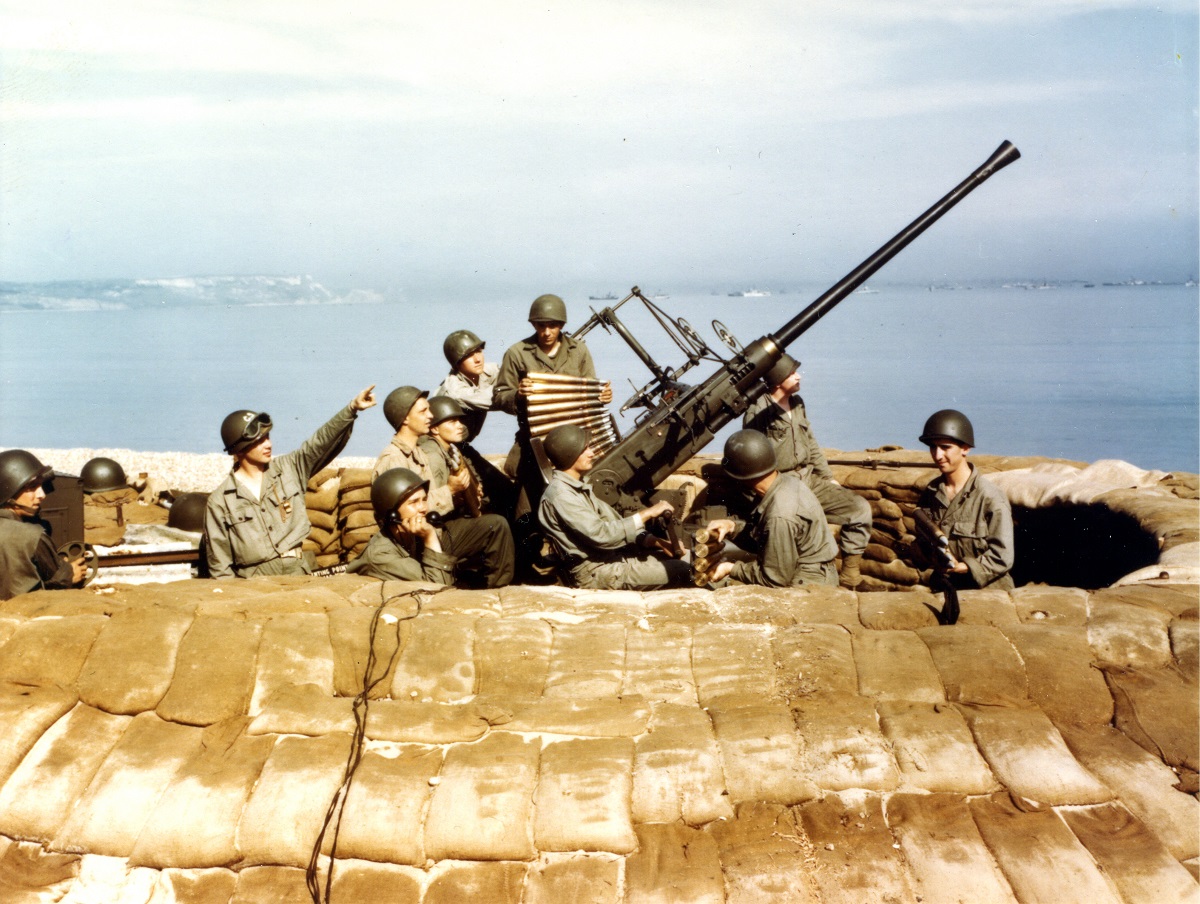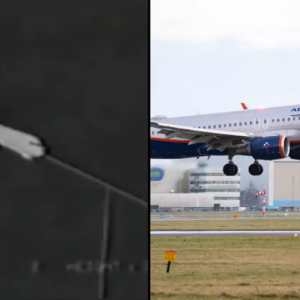The Bofors 40MM Revolutionized Anti-Aircraft Combat

The job of an anti-aircraft gun is surprisingly demanding. It must be able to destroy or deter a fast-moving target by aiming not where it is, but where it will eventually be, depending on many factors. High-speed aircraft, when first introduced, were small targets and were incredibly hard to hit with accurate fire before the introduction of guided missiles. Anti-aircraft guns when first introduced didn’t focus on hitting aircraft with precise accuracy and instead relied on sheer volume to bring down planes. This was the case with the Bofors 40 mm, which was designed in the 1930s and is so effective that it is still in use today.
Although this gun is often seen in WWII images and films in British and American service, neither of these countries actually designed it. That distinction goes to Sweden, which, ironically, was a neutral country during the conflict.
Development

A United States Army soldier sights from a 40mm Bofors gun, ca 1940s. (Photo by PhotoQuest/Getty Images)
In the early 1920s, Sweden’s Navy desired a more capable replacement for their Vickers Pom-Pom anti-aircraft guns. The navy handed this request over to Bofors, who entered into a contract in 1928. Soon into this new weapon’s development, Bofors encountered problems with its cycling. Compared to most fast-firing weapons, this design used a much larger 40 mm round. Any system that was capable of handling the forces involved with such rounds was also too heavy to fire quickly.
After a few changes were made to the feed mechanism in 1930 the weapon began to fire at an acceptable rate. Interestingly, around this time Krupp (the major German industrial company that produced tanks, guns, battleships, and U-boats for Nazi Germany during WWII) purchased a one-third share of Bofors. Fortunately, Bofors kept their new anti-aircraft weapon a secret.
The weapon was ready for production by 1933.
The result was an anti-aircraft gun that could fire 900-gram high-explosive shells to a maximum of 23,600 ft. Its real word maximum was around 12,500 ft. The gun operated on a gravity-assisted feeding mechanism that was loaded with four round clips by hand and could achieve a maximum rate of fire of 120 rounds per minute.
Usage

World War Two: Canadian soldiers manning a 40-mm Bofors anti-aircraft gun in Normandy, France, Jun 1944 (Photo by: Universal History Archive/Universal Images Group via Getty Images)
The British inspected the system in 1937, made a few changes, and began building it themselves under license, where it was called the “QF 40 mm Mark I.” After having difficulty laying the weapon on particularly fast-moving aircraft, the British added the Kerrison Director mechanical analog computer, which electronically aimed the gun. While this system was a remarkable piece of engineering, it proved to be impractical in combat, and it was eventually replaced by a much simpler system.
The British held the gun in extremely high regard and put a massive emphasis on its production during the war. In fact, Commonwealth factories produced over 19,000 Bofors 40 mm guns. The gun could be mounted on any platform it could fit, like tanks and even civilian trucks. Both the British Army and Navy made extensive use of the Bofors. During D-Day, Bofors guns were vital in protecting newly captured areas, with crews from the Light Anti-Aircraft Regiment, Royal Artillery shooting down 17 enemy aircraft over the Orne River in France.

The gun crews on a Quad 40mm Bofors gun mount watch the skies from the Colorado-class battleship USS West Virginia (BB-48) during the invasion of Okinawa, Japan, early 1945. (Photo by PhotoQuest/Getty Images)
During the war they were also used as signaling tools, firing color-coded tracers over safe areas of minefields and indicating the directions of enemy movements.
The US was a major manufacturer of the weapon, with the Army and Navy needing large numbers of them. To fulfill these orders production was given to Chrysler. The process of manufacturing the weapon on a large scale was difficult, as the drawings were in Swedish and the dimensions were in metric. Chrysler made changes to the gun’s manufacturing methods to make it faster and easier to build, cutting its original projected production time in half. As a result, Chrysler built a staggering 60,000 guns and 120,000 barrels.
In 1940 the US Navy was shown a demonstration of the weapon, and they knew such a weapon would be extremely useful. However, during the discussions that sought to give the Navy a license to produce the weapon, Sweden requested that the US give them the manufacturing licenses for aircraft in return. The Navy declined, and supposedly, secretly acquired imperial drawings from the British. With these, they started building guns illegally. An official deal was made with Bofors in 1941.
The gun was in such demand that even Germany and Japan operated captured versions.
After the war, the gun remained both in production and in use, with twin mounted guns finding themselves in the M42 Duster self-propelled anti-aircraft gun. One of their more notable roles was aboard AC-130 gunships.
Even today, modernized versions of the Bofors 40 mm gun are still in production.
News
The “Red Zone” – Land Still Abandoned Due to the Dangers Left by the First World War
The “Red Zone” – Land Still Abandoned Due to the Dangers Left by the First World War In the aftermath of the First World War, large areas of northeast France were left in ruin. Years of constant siege warfare along…
Before Becoming a Big-Name Actor, Richard Todd was a Paratrooper Who Fought at Pegasus Bridge
Before Becoming a Big-Name Actor, Richard Todd was a Paratrooper Who Fought at Pegasus Bridge Photo Credit: 1. Sgt. Christie, No. 5 Army Film & Photographic Unit / Imperial War Museums / Wikimedia Commons / Public Domain 2. Silver Screen…
The Potsdam Giants: A Prussian Infantry Regiment Of Nothing But Very Tall Soldiers
The Potsdam Giants: A Prussian Infantry Regiment Of Nothing But Very Tall Soldiers Frederick William I inspecting his giant guards known as The Potsdam Giants, a Prussian infantry regiment No 6, composed of taller-than-average soldiers. Frederick William I of Prussia,…
Ellen DeGeneres cuts a very casual figure as she drives around in her Ferrari
Ellen DeGeneres cuts a very casual figure as she drives around Montecito in her Ferrari… while preparing to embark on her stand-up tour Ellen DeGeneres cut a very casual figure as she made her way around Montecito on Tuesday morning. The…
“I’m heavily tattooed and keep getting rejected for jobs – it’s not fair”
Heavily tattooed OnlyFans star, 23, with multiple piercings on her FACE slams TJ Maxx for rejecting her for a job – accusing retailer of unfairly judging her dramatic look A woman has accused TJ Maxx of rejecting her for a…
All 75 passengers killed in plane crash after pilot let his chirldren control the plane
Praying, turning the engine off by accident and letting KIDS play with the controls: The worst blunders made by pilots before a crash revealed Every time we board a plane, we put our lives in the hands of the pilot….
End of content
No more pages to load











